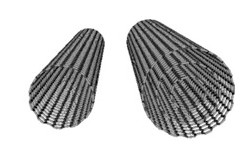Tape gaskets are versatile sealing solutions made from flexible materials, designed to prevent leakage, dampen vibration, and provide insulation in various industrial and commercial applications. They come in adhesive-backed or non-adhesive forms and are used across industries such as automotive, construction, electronics, and HVAC systems. These gaskets are easy to apply, cost-effective, and offer reliable performance in diverse environments.
Understanding the specifications of tape gaskets is crucial for selecting the right product. Below are the primary parameters detailed in lists and tables for clarity.
| Property | Typical Range | Application Notes |
|---|---|---|
| Thickness | 0.5 mm to 10 mm | Thinner gaskets for light sealing; thicker for gap filling and vibration damping. |
| Width | 5 mm to 100 mm | Custom widths available for specific joint sizes. |
| Compression Set | 10% to 40% | Lower percentage indicates better recovery after compression. |
| Temperature Range | -60°F to 500°F (-51°C to 260°C) | Varies by material; silicone handles extremes best. |
| Peel Adhesion | 10 N/25mm to 50 N/25mm | Measures stickiness; higher values for permanent bonds. |
Tape gaskets are used in numerous sectors due to their adaptability. Common applications include:
What materials are tape gaskets made from?
Tape gaskets are typically fabricated from materials such as closed-cell foam (e.g., EPDM, neoprene), open-cell foam, rubber, silicone, or polyurethane. The choice depends on factors like temperature exposure, chemical resistance, and compression requirements.
How do I choose the right tape gasket for my application?
Select based on the operating environment: consider temperature ranges, chemical exposure, UV resistance, and required compression set. For example, use silicone for high heat or EPDM for outdoor weatherproofing. Always check manufacturer specifications for compatibility.
Can tape gaskets be used for outdoor applications?
Yes, many tape gaskets, especially those made from UV-resistant materials like EPDM or certain silicones, are designed for outdoor use. They provide excellent weather sealing against moisture, dust, and temperature fluctuations.
What is the difference between adhesive and non-adhesive tape gaskets?
Adhesive tape gaskets have a pressure-sensitive backing for easy installation onto surfaces, ideal for permanent seals. Non-adhesive versions require mechanical fastening or are used in compression-fit applications, offering reusability and flexibility in placement.
How long do tape gaskets last?
Lifespan varies by material and conditions. High-quality gaskets can last 5-20 years; silicone and EPDM often endure longer due to their resistance to environmental degradation. Regular inspection is recommended for critical applications.
Are tape gaskets resistant to chemicals and oils?
Many are designed with chemical resistance. For instance, silicone and viton gaskets handle oils and solvents well, while neoprene is good for moderate chemical exposure. Always verify compatibility with specific chemicals using manufacturer data.
Can I customize the size and shape of tape gaskets?
Yes, most suppliers offer custom die-cutting services to produce tape gaskets in specific widths, lengths, and shapes to fit unique applications, ensuring optimal performance and waste reduction.
How do I install a tape gasket properly?
Clean the surface thoroughly to remove dirt and oils. For adhesive types, peel the liner and apply firm pressure along the entire length. For non-adhesive types, ensure even compression without over-tightening to avoid deformation.
What temperatures can tape gaskets withstand?
Temperature tolerance depends on the material. Standard foam gaskets may handle -40°F to 200°F, while silicone gaskets can endure -60°F to 500°F. Check the product specs for exact ranges.
Do tape gaskets provide sound insulation?
Yes, especially open-cell foam and certain rubber-based gaskets, which absorb sound waves and reduce noise transmission. They are commonly used in automotive and building applications for acoustic damping.





